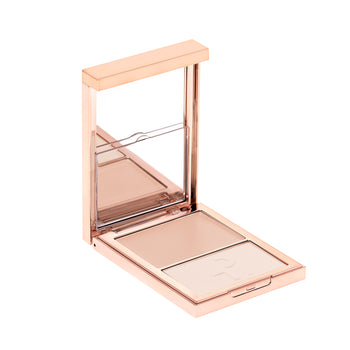Understanding the Types of Foundation Coverage
Understanding the range of foundation coverages is a crucial part of choosing a formula that best suits your needs. They typically fall into three coverage categories: light, medium, and full.
Here’s our guide on foundation coverage and how to find your perfect match.

Light Coverage
Foundations with light coverage offer the sheerest, most subtle look. Formulas like BB creams, CC creams, tinted moisturizers, skin tints, and powder foundations are perfect for a less-is-more look with a lightweight feel.
Go for a lighter foundation on those days when you want to achieve a natural, skin-like finish. It’s not going to fully cover up discoloration or blemishes, but it will blur imperfections and provide subtle color correction for more even-looking skin.
Medium Coverage
Medium coverage foundations are very versatile. They strike a perfect balance, covering up imperfections while still giving you a natural finish. Liquid and cream foundations are commonly designed to provide this level of coverage, which is exactly what you get from our Major Skin Hydra-Luxe Luminous Skin Perfecting Foundation and our Major Skin Crème Foundation & Finishing Powder.
Just like both of our formulas, most medium-coverage foundations are buildable. This means you can add a touch more makeup where you want extra coverage. Apply a single, thin layer for an easy natural look, or blend in more product as needed for fuller coverage.
Full Coverage
To achieve the highest level of coverage, reach for a full-coverage foundation. Perfect for glam makeup, heavy coverage foundation formulas are made with a higher concentration of pigments that almost completely cover imperfections for an even complexion with longer wear.
Most full-coverage foundations are available as either liquids or creams. Like medium-coverage foundations, they are also made to be buildable. Some can feel heavy on the skin, but the best formulas are designed to provide next-level coverage without looking cakey.
What Kind of Coverage is Right for You?
Start by considering your skin concerns and the results you’d like to achieve. For a barely-there no-makeup makeup look, opt for a light coverage formula. On days you want extra coverage, consider going for either medium or full coverage, depending on your specific needs.
Next, select a formula that complements your skin type. For oily skin, a full coverage foundation with a matte finish is ideal to control shine and avoid a heavy feel—but more on finishes shortly. For dry skin, a light coverage formula with hydrating skincare ingredients will make your skin glow.
You can also tailor your foundation choices to different occasions. A light coverage formula may be perfect for daily wear, while a full coverage option works well for special events. If you prefer simplicity, a buildable medium coverage formula can be a versatile all-in-one solution. Ultimately, your preferences and lifestyle will guide your decision.

Finish vs. Coverage: What’s the Difference?
Coverage determines how sheer or opaque the formula is, while finish describes its appearance on the skin.
Common foundation finishes include matte, satin, and dewy, and your choice will depend on your skin type and personal aesthetic.
Matte: These formulas contain oil-absorbing ingredients to reduce shine and give skin a a velvety-soft look , making them a favorite for oily skin types.
Dewy: At the opposite end, dewy foundations provide a luminous, hydrated look, perfect for a fresh, glowing complexion.
Satin: Sitting between matte and dewy, satin finishes offer a balanced semi-matte effect with a natural, soft glow.
Need Application Tips? Got You Covered
There are no rules when it comes to makeup, but there are a few techniques we absolutely swear by for a flawless and natural look, no matter the coverage or finish you’re wearing:
Focus on Skin Prep: The secret to effortlessly beautiful base makeup is properly prepped skin. Prior to your makeup routine, apply a moisturizer to promote smooth, supple skin. After that, apply an even layer of primer all over the face to create an even base for your makeup and give your foundation something to grip onto (which will increase longevity).
Take Your Time with Blending: Blending is key for eliminating unnatural lines and fully working the foundation into your face for the most even, skin-like finish. Take your time blending your foundation with a brush or a beauty sponge to achieve seamless results.
Set with a Translucent Powder & Setting Spray: Increase the staying power of your foundation by finishing your routine with a translucent powder or setting spray (or both!). Mist an even layer of setting spray all over your face to lock your entire look in place, then set it with a translucent powder. This will not only extend the wear of your makeup but can also help keep shine at bay if you have oil-prone skin.
The best foundation coverage for you ultimately comes down to your preferences. Once you have a formula that perfectly suits your skin, you can amplify your beauty and create a gorgeous base for any makeup look.
@patricktabeauty
@patricktabeauty














